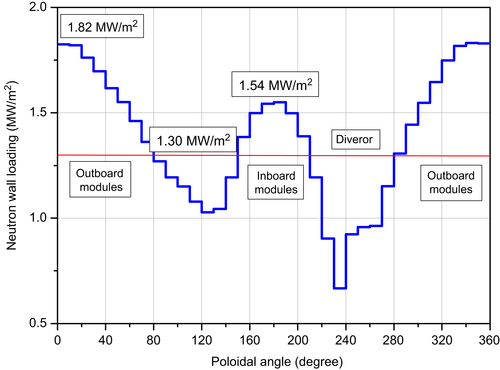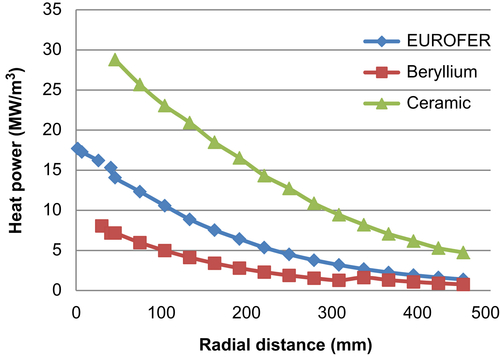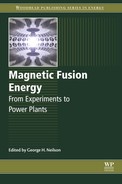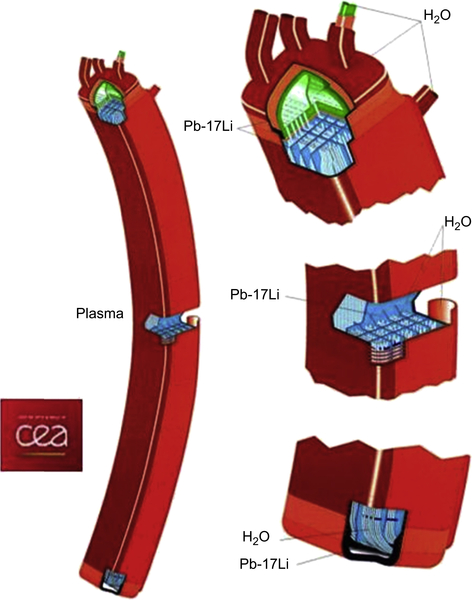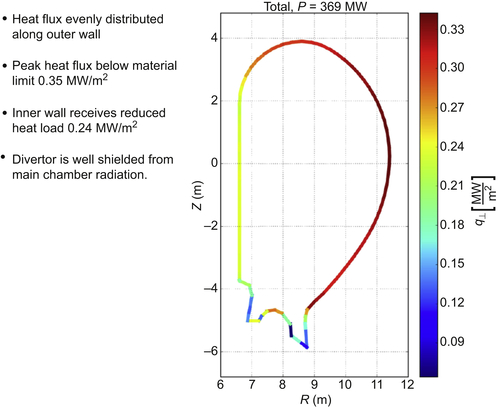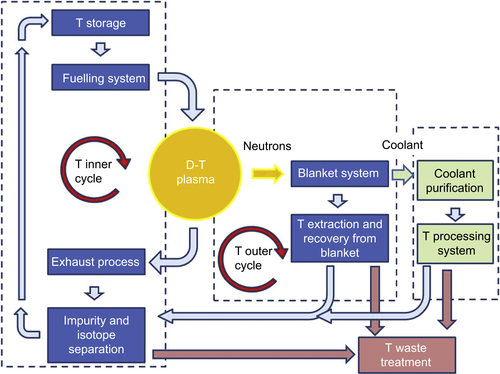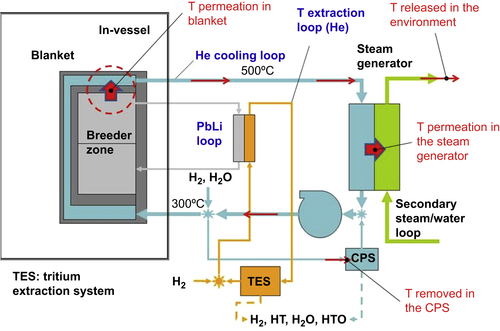[1] Boccaccini L.V, et al. Advanced helium cooled pebble bed blanket with SiCf/SiC as structural material. Fusion Eng. Des. 2000;49–50:491–497.
[2] Boccaccini L.V, et al. Strategy for the blanket testing in ITER. Fusion Eng. Des. 2002;61–62:423–429.
[3] Boccaccini L.V, et al. Materials and design of the European DEMO blankets, (invited paper at ICFRM-11). J. Nucl. Mater. 2004;329–333:148–155.
[4] Boccaccini L.V, et al. Present status of the conceptual design of the EU test blanket systems. Fusion Eng. Des. 2011;86:478–483.
[5] L.V. Boccaccini, et al., Objectives and Status of EURO Fusion DEMO Blanket Studies, Presented to ISFNT-12 for Publication in Fusion Engineering and Design.
[6] Bubelis E, Hering W. Technical note “selection of coolant for the heat storage system of DEMO BoP, analysis of dwell time influence on the heat storage capacity requirements, cost and storage dimensions, and analysis of the potential to provide the needed in-house electricity needs for DEMO” KIT report No. INR-10/14. Fusion. 2014;446.
[7] Bubelis E, Hering W. Report on conceptual designs of PHTS, ESS and PCS components for DEMO BoP with helium cooled BB and water cooled BB concepts. EUROfusion WPBoP. 2015.
[8] Calderoni P, et al. Options and methods for instrumentation of test blanket systems for experiment control and scientific mission. Fusion Eng. Des. 2014;89:1126–1130.
[9] Chen H. Conceptual design and analysis of the helium cooled solid breeder blanket for CFETR. Fusion Eng. Des. 2015;96–97:89–94.
[10] Cho S.Y, et al. Feasibility study of fusion breeding blanket concept employing graphite reflector. Fusion Eng. Des. 2015;98–99:1747–1750.
[11] KfK 5429, Forschungszentrum Karlsruhe. In: Dalle Donne M, ed. European DEMO BOT Solid Breeder Blanket. 1994.
[12] C. Day, et al., Consequences of the Technology Survey and Gap Analysis on the European R&D Programme of the DEMO Inner Fuel Cycle, Presented to ISFNT-12 for Publication in Fusion Engineering and Design.
[13] Demange D, et al. Tritium management and anti-permeation strategies for three different breeding blanket options foreseen for the European power plant physics and technology demonstration reactor study. Fusion Eng. Des. 2014;89:1219–1222.
[14] D. Demange, et al., Tritium Extraction Technologies and DEMO Requirements, Presented to ISFNT-12 for Publication in Fusion Engineering and Design.
[15] El-Guebaly L.A, Malang S. Toward the ultimate goal of tritium self-sufficiency: technical issues and requirements imposed on ARIES advanced power plants. Fusion Eng. Des. 2009;84:2072–2083.
[16] Enoeda M, et al. R&D status on water cooled ceramic breeder blanket technology. Fusion Eng. Des. 2014;89:1131–1136.
[17] G. Federici, Design Approach and Prioritization of R&D Activities Towards an EU DEMO, Presented to ISFNT-12 for Publication in Fusion Engineering and Design.
[18] Fisher U, et al. Neutronic design optimization of modular HCPB blankets for fusion power reactors. In: 23rd Symposium on Fusion Technology (SOFT), Venice. September 20–24, 2004.
[19] Giancarli L, et al. In-vessel component designs for a self-cooled lithium-lead fusion reactor. Fusion Eng. Des. 2003;69:763–768.
[20] Giancarli L, et al. Development of the EU water-cooled Pb-17Li blanket. Fusion Eng. Des. 1998;39–40:639–644.
[21] Giancarli L.M, et al. Overview of the ITER TBM program. Fusion Eng. Des. 2012;87:395–402.
[22] Gohar Y, et al. High power density self-cooled lithium–vanadium blanket. Fusion Eng. Des. 2000;49–50:551–558.
[23] W. Hering, E. Bubelis, Balance of plant – status and plans, Workshop on DEMO Physics and Technology R&D, IPP Garching, September 2nd and 3rd, 2014.
[24] Hermsmeyer S, Malang S, Fischer U, Gordeev S. Lay-out of the He-cooled solid breeder model B in the European power plant conceptual study. Fusion Engineering and Design. 2003;69:281–287.
[25] Hoshino T. “Development of advanced tritium breeding material with added lithium for ITER-TBM”. J. Nucl. Mater. 2011;417:684–687.
[26] Huang Q, et al. Recent progress of R&D activities on reduced activation ferritic/martensitic steels. J. Nucl. Mater. 2013;442:2–8.
[27] Hubberstay P, Sample T. Pb-17Li-water interaction: a thermodynamic and experimental characterization. J. Nucl. Mater. 1993;199:149–158.
[28] Janeschitz G, et al. Overview of the divertor design and its integration into RTO: RC-ITER. Fusion Eng. Des. 2000;49–50:107–117.
[29] Knitter R, Löbbecke B. Reprocessing of lithium orthosilicate breeder material by remelting. J. Nucl. Mater. 2007;361:104–111.
[30] Knitter R, et al. Recent developments of solid breeder fabrication. J. Nucl. Mater. 2013;442:420–424.
[31] Konys J, et al. Comparison of corrosion behavior of EUROFER and CLAM steels in flowing Pb–15.7Li. J. Nucl. Mater. 2014;455:491–495.
[32] Van der Laan G, Conrad R. Analysis of performance data from ceramic breeder irradiation experiments. Fusion Eng. Des. 1998;39–40:751.
[33] G. Laffont, L. Cachon, V. Jourdain, J-M. Fauque, ASTRID power conversion system, FR13: assessment on steam and gas options, Fast Reactors and Related Fuel Cycles: Safe Technologies and Sustainable Scenarios, FR13, Proceedings of an International Conference, Paris, France, 4–7 March 2013.
[34] J.-H. Lee, et al., Thermal-Hydraulic Analysis of Water Cooled Breeding Blanket of K-demo Using MARS-KS Code, http://dx.doi.org/10.1016/j.fusengdes.2015.05.029.
[35] Liu S, et al. Conceptual design of a water cooled breeder blanket for CFETR. Fusion Eng. Des. 2014;89:1380–1385.
[36] Maisonnier D, et al. The European power plant conceptual study. Fusion Eng. Des. 2005;75–79:1173–1179.
[37] KfK-Report 5424. In: Malang S, Schleisiek K, eds. Dual Coolant Blanket Concept. November 1994.
[38] Malang S, Raffray A.R, Morley N.B. An example pathway to a fusion power plant system based on lead–lithium breeder: comparison of the dual-coolant lead–lithium (DCLL) blanket with the helium-cooled lead–lithium (HCLL). Fusion Eng. Des. 2009;84:2145–2157.
[39] Merola M, Danner W, Palmer J, Vielder G, Wu C.H, The EU ITER Participating Team. European contribution to the development of the ITER divertor. Fusion Eng. Des. 2003;66–68:211–217.
[40] Mitteau R. A shaped first wall for ITER. J. Nucl. Mater. 2011;415:969–972.
[41] Nishikawa M, et al. Release behaviour of bred tritium from LiAlO2. J. Nucl. Mater. 2004;335:70.
[42] Norajitra P, Bühler L, Fischer U, Gordeev S, Malang S, Reimann G. Conceptual design of the dual-coolant blanket in the frame of the EU power plant conceptual study. Fusion Engineering and Design. 2003;69:669–673.
[43] Norajitra P. Divertor Development for a Future Fusion Power Plant. , 2192-9963KIT Scientific Publishing; 2011: 978-3-86644-738-7.
[44] Okano K, et al. DEMO design activities in the broader approach under Japan/EU collaboration. Fusion Eng. Des. 2014;89:2008–2012.
[45] Park J.S, et al. Pre-conceptual design study on K-DEMO ceramic breeder blanket. Fusion Eng. Des. 2015;100:159–165.
[46] Pereslavtsev P, et al. Neutronic analyses of the HCPB DEMO reactor using a consistent integral approach. Fusion Eng. Des. 2014;89:1979–1983.
[47] Piazza G, et al. Heat transfer in compressed beryllium pebble beds. Fusion Eng. Des. 2003;69:227–231.
[48] Poitevin Y, et al. The test blanket modules project in Europe: from strategy to the technical plan over next 10 years. Fusion Eng. Des. 2007;82:2164–2170.
[49] Y. Poitevin, et al., Expected Return on Experience From European TBM Systems: What to Measure, How to Measure, What to Expect, Plenary Talk PL09 Taken to the ISFNT-12, Jeju, Korea.
[50] Proust E, et al. Breeding blanket for DEMO. Fusion Eng. Des. 1993;22:19–33.
[51] Raffray A.R, et al. High performance blanket for ARIES-AT power plant. Fusion Eng. Des. 2001;58–59:549–553.
[52] Rapisarda D. Overview of DCLL research activities in the EU/Spain. In: 26th IEEE Symposium on Fusion Engineering (SOFE), Austin, Texas, USA. 2015.
[53] Sardain P, et al. Power plant conceptual study – WCLL concept. Fusion Eng. Des. 2003;69:769–774.
[54] Sardain P, et al. The European power plant conceptual study: helium-cooled lithium–lead reactor concept. Fusion Eng. Des. 2006;81:2673–2678.
[55] Sawan M.E, Abdou M.A. Physics and technology conditions for attaining tritium self-sufficiency for the DT fuel cycle. Fusion Eng. Des. 2006;81:1131–1144.
[56] Someya Y, et al. Design study of blanket structure based on a water-cooled solid breeder for DEMO. Fusion Eng. Des. 2015;98–99:1872–1875.
[57] Song Y.T, et al. Concept design of CFETR Tokamak machine. In: IEEE 25th Symposium on Fusion Engineering, June 9, 2013, San Francisco, USA. 2013.
[58] Stork D, et al. Materials R&D for a timely DEMO: key findings and recommendations of the EU roadmap materials assessment group. Fusion Eng. Des. 2014;89:1586–1594.
[59] Uchida M, et al. Elementary development of beryllide pebble fabrication by rotating electrode method. Fusion Eng. Des. 2003;69:491–498.
[60] K. Willnow, Carbon Capture & Storage (CCS) – A Technology Overview, UNECE Energy Week Geneva, November 18, 2008, http://www.unece.org/fileadmin/DAM/energy/se/pp/clep/ahge2/18Nov08/3_Willnow.pdf.
[61] Ying A. Status of ceramic breeder pebble bed thermo-mechanics R&D and impact on breeder material mechanical strength. Fusion Eng. Des. 2012;87:1130–1137.





